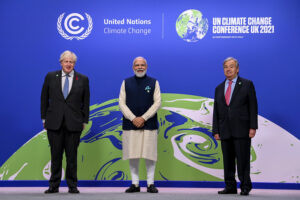
Picture courtesy: Karwai Tang via COP26 on Flickr
Background: One of the most important climate summits under the United Nations Framework Convention on Climate Change (UNFCCC), the CoP-26 recently took place in the Scottish city of Glasgow in United Kingdom. The importance of this emanates from the critical state of the Earth’s climate and other ecological balances, which are facing a near collapse. Just weeks before the summit began on October 31, the Intergovernmental Panel on Climate Change, the apex UN scientific body composed of scientists, economists, planners etc. from all across the world released the first part of its latest, and Sixth periodic Assessment Report (AR6), WG one report . The part one (or report of the Working Group 1) deals with the “Physical Science Basis” of the Climate systems, or the actual changes that have happened recently, the changes that are taking place and the projections for different time scales, extending up to the end of this century, until the year 2100. The projected scenarios as per the present course of the emissions and actions, what is called the Business As Usual (BAU), are all scary and potentially completely destabilizing for our civilisation. That’s where the call for drastic and immediate actions to change course from the very large extraction-burning of fossil fuels and deforestation, and resulting Green House Gas (GHG) emissions have all become very important.
The Glasgow climate summit CoP-26 was the most important following the 2015 Paris climate summit, or CoP-21, where the Paris Agreement (PA) for limiting global annual mean temperature rise to “well below 2 Celsius from the pre-industrial average”, and best efforts to limit this rise to within 1.5 C above pre-industrial, was agreed on by most member countries. The second biggest current GHG emitter, USA (which is also the highest cumulative GHG emitter country), walked out of the PA during the Trump presidency, but soon after Joe Biden assumed charge – it rejoined the PA in 2021, raising some hopes of decisive climate actions by all major emitter nations. Before the Glasgow CoP-26 began, all major emitters had already “committed” to reach what is called “net-zero emissions” (a concept many climate justice movements contest and reject as false solution). “Net-Zero” emissions means that, though that particular country will not or may not completely stop emitting the Green House gases like Carbon Dioxide CO2, methane CH4, nitrous oxides N2O, CFCs, etc, it will do some other actions to suck in the emitted GH Gases from out of the atmosphere and store it long term (called Sequestration) in some form. Green plants do this sucking out of CO2 from the atmosphere, to a varied time scale, and for very different time periods. There are a host of other technologies being developed for doing this without resorting to trees etc.
In this regard, many eyes were on what India will do at the CoP-26, as India is the third largest GHG emitter globally (following China, the largest and USA the second largest), though India’s per person emission is still much lower than the global average.
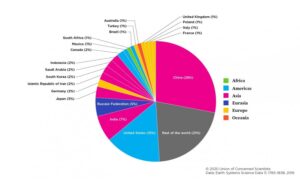
PM Modi’s CoP-26 announcements as part of India’s National Statement: Though the Indian political and bureaucratic leadership denied any intention of declaring a “net-zero” target at CoP-26, global political pressure on India was high to do so, as all other major economies have already done this – with most declaring a 2050 Net-Zero deadline, with China announcing a 2060 target. And as it often happens, combined with the Indian PMs never-ending desire for grand-standing, in the first week of the CoP-26 itself, in his address to the conference, Narendra Modi announced India’s “Gift to the world in the form of ‘Pancha amrit tatva’”, a set of five “promises of elixir” as India’s climate actions.
The most hyped promise or “amrit tatva’ is the announcement that India will achieve “net-zero” emissions by the year 2070, meaning that India will reduce its GHG emissions drastically by 2070, and whatever is the remaining GHG emissions by that year, other actions to sequester that emission will be fully sucking in that emission, every year. As part of India’s National Statement at the CoP-26, which PM Modi delivered, the promises were:
- India will achieve “net-zero” emissions by the year 2070;
- India will have an installed capacity of “500 GW of non-fossil energy capacity by 2030”;
- India will meet at least “50% of its energy requirements through RE” by 2030;
- India will reduce its “projected emissions by one billion tons” by 2030; and
- The carbon (emission) intensity of India’s economy will be reduced by 45% (from the base year of 2005) by the year 2030.
In this article, we will only look closely in to the “promises” directly connected to Renewable Energy (RE).
As one might recall, during the Paris climate summit India had promised to achieve an installed Non-Fossil fuel electricity capacity of 40% of the total installed electricity capacity by the year 2030 , on top of its 2022 target of achieving 175 GW on installed RE capacity (comprising of 100 GW of Solar, 60 GW of wind and rest from biomass, small hydro etc). That way, the Glasgow announcements are a substantial upgrade, and it is just what the global political pressure had wanted.
Taking a closer look at the announcements: To take a closer look at the Glasgow announcement nos. 2 and 3 mentioned above, we need to understand some confusions that are there in India’s announcements. There are three types of confusions that persist in India’s energy related announcements. One interesting aspect of India’s ‘grand announcements’ is the continuous confusion between ‘Energy’ and ‘Electricity’. Every announcement made in this regard, whether at Paris or Glasgow, refers to “Energy”, while what they are actually referring to in most cases is “electricity”. It seems the “experts” at the ministry, who are preparing PM’s speech are not clear that these two are Not synonymous. Electricity is a subset of the total energy that a country or society or even a family consumes. In the case of India, the energy that we consume as Electricity is less than 20% of the total primary energy consumed in the country as a whole, in all sectors, by all activities (leaving apart unaccounted and small traditional biomass uses, but including a major part of biomass, which is renewable). Thus, from PM Modi’s announcements, it’s always a bit unclear exactly what percentage of India’s Total Primary Energy Basket will be from RE (which is far less than the percentage of electricity from RE).
The second confusion or mix-up is that Non-fossil energy includes Nuclear fission based energy (non-renewable and high carbon intensity in the short to medium term) as well as big hydropower (which has now been reclassified by the Government of India as ‘renewable’, thus increasing its RE capacity by over 45 GW overnight, ‘at the stroke of a pen’). Thus, 40% of installed capacity from non-fossil energy sources do not mean 40% from RE, a mistake often committed by both media and expert commentators alike.
A third recurring confusion seems to be between the meanings of the terms “installed energy/electricity capacity” and “energy generation”. There are big differences between the installed capacity based total power (or electricity) generation between different forms of energy sources, based on their “plant load factors PLF” or “capacity factors CF”. Thus even “40% of installed capacity from RE sources” do not mean that 40% of the total electricity generation will come from RE sources. Solar and Wind energy have generally low PLFs, in comparison to coal-based or nuclear power capacity, which have higher PLFs. Thus, to fully replace the total electricity generation from a 1000 MW Coal power plant running at 60% PLF, one needs about 3000 MW of installed solar or wind power capacity.
Looking at PM’s RE announcement no.2 at the Glasgow CoP-26, one is first struck by the massive increase in the number – 500 GW (or 500,000 MW) of installed Non-Fossil (NF) electricity capacity by 2030 will be a stupendous task, along with its attendant issues of massive land requirement (for the RE components – as nuclear do not need that much land/ MW of installed capacity) and potential displacement and others. At the end of 2021, India’s total installed Renewable energy (by changed definition) capacity stands at about 151 GW, including large hydropower (all figures rounded to nearest GW, also some ongoing/ near completion projects might add a couple of GW). Out of this, Solar Photo Voltaic (S-PV) capacity has expanded the fastest over the last decade, now standing at about 50 GW. Another 40 GW is the installed capacity of wind power, and with over 46 GW of large hydro, 10+ GW of biomass based electricity capacity and 5 GW of small hydro, the total is about 151 GW.
To understand the seriousness and preparations for these announcements by the PM, one can look back to the Paris CoP-21 announcements by him in 2015. As per those, by the year 2022, India was to achieve 175 GW of installed RE capacity, and going by the definition then, this excludes large hydro. The year 2022 has started and India’s installed RE capacity, excluding large hydropower, stands at about 105 GW in January 2022. Projections show another 10+ GW of intended / undergoing installations this year, which might bring the total to about 115 GW by the end of this year.
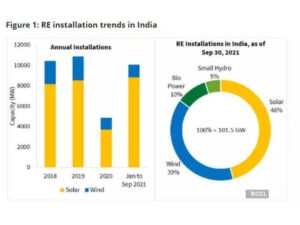
Source Central Electricity Authority, chart by JMK Research/ Economic Times.
This is a reasonably good progress, but only about 66% of the targeted 175 GW, definitely not something to clap about. Also, as can be seen from the annual installations figures, the required scaling up of annual capacity additions are not happening over the last 4 years, and India is stuck at around 10+ GW of annual capacity addition per year. Of course, one can expect that in true Modi-style deception and falsehood, the 46 GW of large hydropower capacity will be added on and the “achievement” by 2022 end will be shown to be about 161 GW, or about 92% of the 175 GW target. The other PA announcement of 40% of installed capacity from non-fossil sources, was so un-ambitious, that it will be easily surpassed, as the present installed capacity of NF sources, including the 6.78 GW of nuclear capacity, is about 158 GW, out of a total installed power capacity of about 397 GW, or about 40% already. Please note, that this is only 40% of “installed capacity from NF sources, not of total power generated (which is a much lower figure due to much lower PLF of RE sources), as explained earlier.
For our clarity, let us assume that out of the 500 GW of projected NF electricity capacity by 2030, a maximum of 20 GW (though 15 GW seems a more likely number) will come from nuclear. The present nuclear capacity is a meagre 6.78 GW, and nuclear power plants under various stages of construction at Kudankulam, Fatehabad, Chutka etc might add 8-9GW, and at most a couple more might come online by 2030. Nuclear power plants take at least 10 years from design to completion, so those not already beginning construction, have little chance of being on grid before 2030 (in this analysis, we are not looking at the massive inherent problems of nuclear fission power plants, just giving figures). Large hydro power can possibly add another 50 GW or so on top of the 46 GW existing, despite massive resistance by people and massive ecological impacts. Thus, if we take out 100 GW of installed large hydro and a generous 20 GW of installed nuclear electricity capacity by 2031, and add the ‘existing’ 115 GW new renewable by end 2022, India will still need to add another 265 GW of new (or excluding large hydro & nuclear) capacity in the next eight years. This is a stupendous task, adding 33 GW of renewable electricity capacity each year on the average, or about three times the current achievement, and the 200% increase coming almost overnight! Even as great a magician as PC Sorcar would have failed probably!
China is the only country, with by far the world’s largest capacity to manufacture Solar PV, from ingots to wafers to assembled panels, which has achieved and surpassed this figure. Not even the USA or entire Europe has been able to reach this as of now. It is ridiculous to claim that India, with no Solar PV manufacturing capacity worth mentioning even in 2021 end, and completely dependent on import of solar panels, will be achieving something similar to what China has achieved, in the near term at least. The financial massive investments needed in building extremely pure Silicon ingots and wafer manufacturing has not materialised even now.
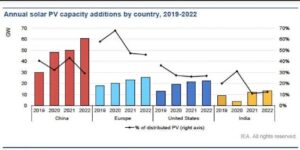
Graph by International Energy Agency
Though it is claimed that the top 11 domestic solar PV module manufacturers are planning to do massive capital expenditure of around INR 50,000 crores by 2025, in boosting their total manufacturing capacity up to 400% in the next four years, these are just projections (*7). Even if that happens by some magic by 2025, it will be quite late to achieve the 33GW+ capacity addition of new RE per year, every year from 2023 to 2030. Thus, it is reasonable to assume that India will fall short of adding another 265 GW of RE capacity (excluding large hydro) in just the next eight years. PM Modi or his successors will have to invent new magic tricks (like he did by declaring large hydro as renewable) to go anywhere near that figure.
Now let’s take a close look at announcement no 3, that India will get 50% of its “energy requirement from RE by the year 2030! Here again, it seems the two persistent confusions between “energy generation” and “installed electricity generation capacity”, and “total energy production” vs. “electricity production” is present. Even if one disregards the “50% of total energy” claim, and take it (with a ‘fistful’ of salt) to be “50% of total electricity generation”, this still sounds out of reach. At present, with an installed RE capacity of 151 GW, and about 396 GW of total installed electricity capacity, the total annual generation of electrical energy, or power from conventional sources (Coal, Gas, Hydro) is about 1380 TWh 1380 Billion units. Note that this figure has not changed much over the last three years (figure below from Central Electricity Authority).
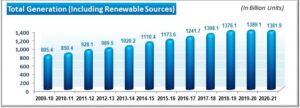
While RE electricity capacity has increased the fastest, and so has the percentage of RE as installed capacity of total, the total generation from RE excluding large hydro) is still only about 150 TWh, or about 10-11% of total electrical energy produced in India (figure below). From about 11% to 50% in flat eight years, again, will be a magic trick worth a Sorcar or mandrake may be? Even if large hydro is considered as an RE source and included in the RE contribution, it is just about 20-21% of the total now. Scaling this up to 50% is theoretically possible, but a very challenging task, to put it mildly. Again, the huge gaps in indigenous RE manufacturing capacity will come in the way, which has no easy and quick fix.
And if one takes this announcement literally, that is “50% of our total energy requirements to come from RE by 2030”, the absurdity of it reaches very high levels, as currently not even 5% of India’s primary energy is coming from RE, but let us disregard this as part of the three confusions.
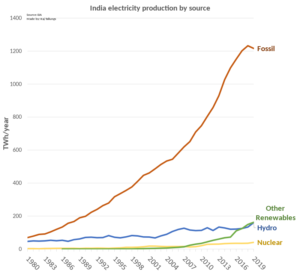
Figure by Kaj Tallungs – Own work, CC BY-SA 4.0,
Thus, we can see that India has not really prepared in any way for achieving the RE targets announced by PM Modi in Glasgow. Perhaps, these were not even clearly known to people in the government who would be called upon to achieve these targets, once announced by the PM. Perhaps these are not even meant for actual achievement, but for grandstanding. True Modi style.
Centre for Financial Accountability is now on Telegram. Click here to join our Telegram channel and stay tuned to the latest updates and insights on the economy and finance.
